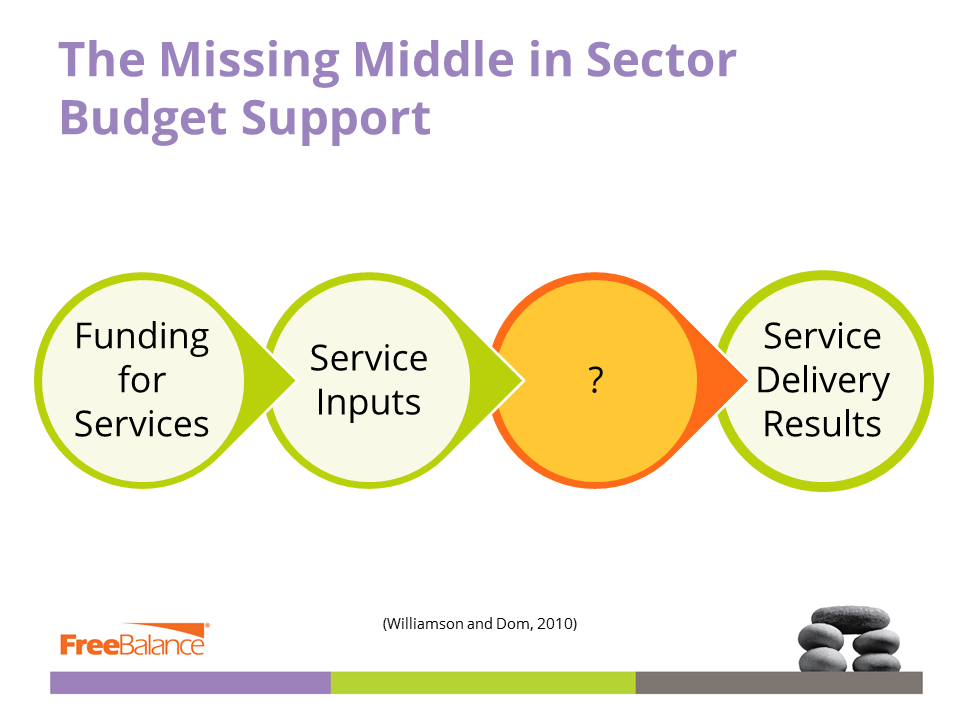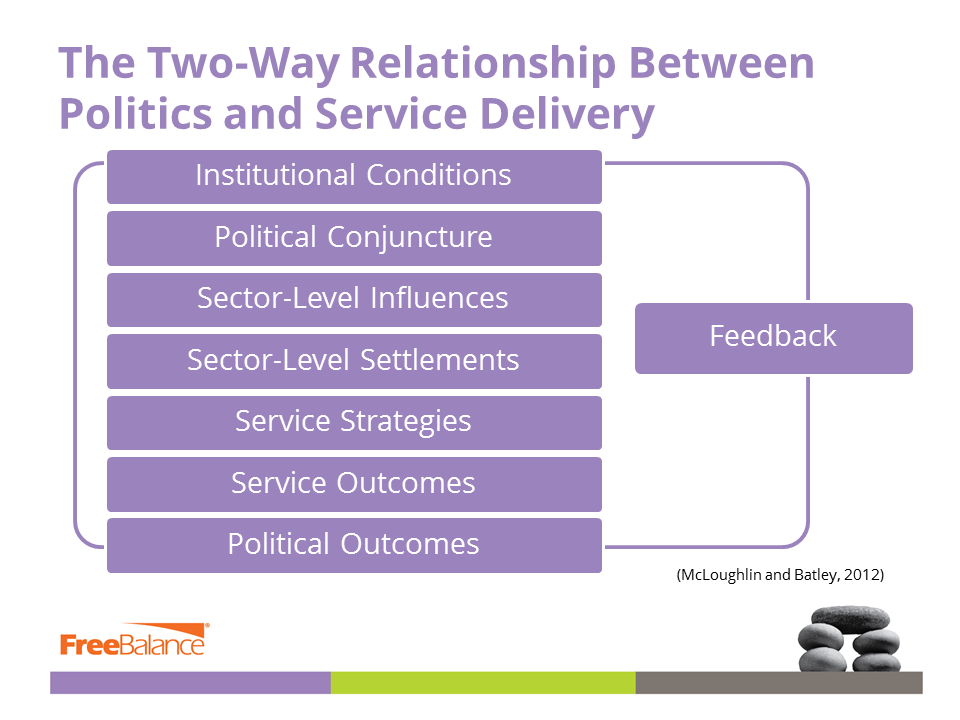My post yesterday described how smart public finances – through improvements in Public Financial Management (PFM) – can lead to better citizen services. The operative word is “can”. Evidence shows that citizen service delivery is complex. It is somewhat frustrating that “there is surprisingly little academic research on why budgetary outlays are not resulting into better service delivery outcomes (Bandypadhyay, 2016)” Nevertheless, it is clear that governments need to improve more than PFM to achieve better citizen services outcomes.
Why is Smart Public Financing not enough to improve Service Delivery?
Smart PFM can improve many aspects of government efficiency and effectiveness. Many observers consider PFM as having cross-cutting impacts. “Effective PFM systems will support the delivery of …objectives but improved PFM systems will not immediately result in an improvement in these areas. Other non-PFM related factors also affect these domains…(Welham et al, 2013)” These factors are necessary to achieve the full realization of smart public finance initiatives (Williamson and Dom, 2010).

The political environment in governments often determines whether improvements in financial management result in improvements in service delivery. Political will and committed managers are required (Hasnain, 2017), as is “more emphasis on accountability for results (Foster, 2008)” . “PFM reforms and their effects on service delivery require rigorous monitoring and evaluation. (Broadbent, 2010)”
Any initiative to improve public finances “depend on the effective reforms in other areas (Pretorius and Pretorius, 2008)” In other words, “Getting resources to the right places on time gives an opportunity for other interventions to improve service delivery to work (Foster, 2008)”
Service delivery represents a more complex “cause and effect” environment. The linking of PFM improvements with other factors, especially political factors, has wide ranging impact. “It isn’t only that politics determines service delivery, but that in turn, service delivery determines forms of politics. (McLoughlin and Batley, 2012) “
What is the Citizen role in Accountability for improved Service Delivery?
Smart PFM systems can aid fiscal transparency through budget, procurement, spending and results portals. This is because all government activities are budget-driven. Transparency and accountability assist in improving service delivery. Yet, “greater transparency in most countries has not triggered many citizens to use the newly available information. Without citizens acting on this information to hold their leaders accountable, the problems of poor quality government services persist. (Bandypadhyay, 2016)”

Citizens need a sense of efficacy to leverage fiscal transparency to improve accountability. The social, cultural and political environment combined with how transparency is provisioned “may influence the extent to which citizens can engage in collective action (McLoughlin and Batley, 2012).” The combination of top-down and bottom-up social accountability appears to be more effective in improving service delivery (McLoughlin and Batley, 2012)
What is the Importance of Civil Service Capacity?
Although automation using Government Resource Planning (GRP) systems can overcome some deficiencies in civil service capabilities, it is becoming evident that government human resources capacity is needed to improve citizen service delivery. “Human resource management practices also matter a great deal. The soft aspects of human resource management, such as employee satisfaction and morale, are considered to be the most important drivers of performance. (Curristine et al, 2007)”
Effective staff wages (Welham et al, 2013) are “ important for attracting and retaining qualified staff, especially in case of skill shortages. Curristine et al, 2007)”
Public service accountability requires public service capacity. Public servants cannot be held accountable for service delivery results without the appropriate capabilities. This includes skills and enabling environments. “Capacity building must be accompanied by control over resources [and] giving managers increased authority over a reliable budget can improve motivation from doing a good job even if can’t raise pay (Foster, 2008)”
Capacity in service delivery is particularly important in fragile states. Effectiveness of spending on important objectives like health and education relies on public service capacity (Slater, 2012).
How does improved PFM enable Sectoral Performance?
Public finance improvements can impact many elements of government service delivery.
“Improvements in service delivery Strengthened PFM systems should support more efficient and effective delivery of public services by facilitating the flow of funds from the centre to front-line units. This requires improvements in PFM functionality that span the service chain, reaching beyond the central finance agency and line ministries to regional governments, local administrations and service units (such as schools and clinics). (ODI, 2012)”
There are many observers who propose more focused improvements to PFM. “PFM reforms need to be designed at sector level in order to accommodate the needs, capacities and willingness of public sector workers in different areas of service provision. (Broadbent, 2010)” Meanwhile other observers recognize the cross-cutting impact of PFM. “The focus on sector budgets and line ministries takes focus away from services which are delivered across government and overall budget allocations. (Pretorius and Pretorius, 2009)”
It might be better to consider certain PFM improvements tied to sectors when it relates to government objectives. This notion of “Sector Budget Support” (Williamson and Dom, 2010) could be a powerful way to improve service delivery by linking PFM with sector interventions.
Why is PFM Change Management Critical to Service Delivery Improvements?
Organizational change management is necessary for any transformation of service delivery because of the complex nature of government practices (Andrews, 2013). Important public finance improvements can increase resistance because process automation and forms of accountability can lead to fears of job replacement. Therefore, smart public finance initiatives need to consider the political, accountability and capacity environment. The institutional environment and government economic stability need to be considered.
References
Andrews, M; Pritchett, L; Woodcock, M. Building State Capacity: Evidence, Analysis, Action. Oxford University Press, 2017. http://bsc.cid.harvard.edu/building-state-capability-evidence-analysis-action
Andrews, M. The Limits of Institutional Reform in Development: Changing Rules for Realistic Solutions. Cambridge University Press, 2013. http://www.cambridge.org/catalogue/catalogue.asp?isbn=1139603477
Bandypadhyay, S. Linking PFM Reforms to Service Delivery Outcomes. Middle East Review of Public Administration (MERPA), 2016. https://merpa.scholasticahq.com/api/v1/attachments/1323/download
Broadbent, E. Public Financial Management and Frontline Service Delivery. Governance and Social Development Resource Centre, January 2010. http://www.gsdrc.org/publications/public-financial-management-and-frontline-service-delivery/
Curristine, T: Lonti, Z; Joumard, I. Improving Public Sector Efficiency: Challenges and Opportunities. OECD Journal on Budgeting, 2007. https://www.oecd.org/gov/budgeting/43412680.pdf
Foster, M. Sector Budgeting and Resource Allocation. Centre for Aid and Public Expenditure (CAPE), November 2008. http://www.odi.org.uk/events/2008/11/12/295-presentations-session-2.pdf
Hasnain, Z. Can digital technologies spur public administration reform? Governance for Development, the World Bank, February 16, 2017. https://blogs.worldbank.org/governance/e-bureaucracy-can-digital-technologies-spur-public-administration-reform
McLoughlin, C; Batley, B. The Politics of What Works in Service Delivery: An Evidence-based Review. Effective States and Inclusive Development Research Centre (ESID) , February 2012. http://www.effective-states.org/wp-content/uploads/working_papers/final-pdfs/esid_wp_06_mcloughlin-batley.pdf
Pretorius, C; Pretorius, N. Review of Public Financial Management Reform Literature. UK Department for International Development. January 2009.
https://www.gov.uk/government/uploads/system/uploads/attachment_data/file/67738/review-pub-finan-mgmt-reform-lit.pdf
Slater, R. Service delivery and state-building: the 46.7 billion dollar question? Overseas Development Institute, October 25, 2012. https://www.odi.org/comment/6884-service-delivery-state-building-conflicted-affected-states
Welham, B; Krause, P; Hedger, E. Linking PFM dimensions to development priorities. Overseas Development Institute, May 2013. https://www.odi.org/sites/odi.org.uk/files/odi-assets/publications-opinion-files/8392.pdf
Williamson, T; Dom, C. Sector Budget Support in Practice. Overseas Development Institute, February, 2010. http://isndemo.atlasproject.eu/asset_demo/file/cec8e5ba-5ca2-4762-9335-b14a7ecd87ab/d3b1d8a9-ecb6-4063-8b13-c4177bf822c0/2010-02_Reports_SectorBudget_Note.pdf
—Improving public sector financial management in developing countries and emerging economies. Association of Chartered Certified Accountants (ACCA), 2010. http://www.accaglobal.com/content/dam/acca/global/PDF-technical/public-sector/tech-afb-ipsfm.pdf
—Public financial management reform in fragile states: Grounds for cautious optimism? Overseas Development Institute, October 2012. https://www.odi.org/sites/odi.org.uk/files/odi-assets/publications-opinion-files/7840.pdf
